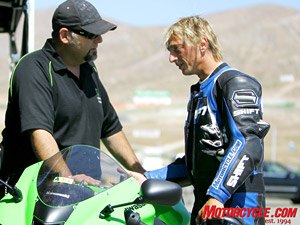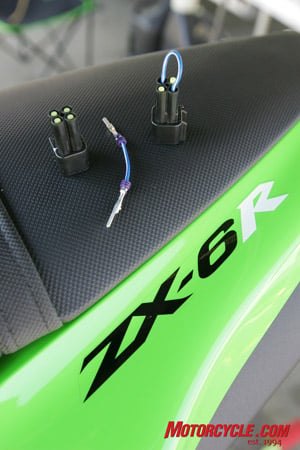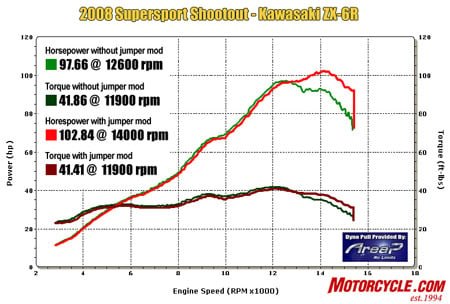By Kevin Duke
Pity the poor sportbike engineers who must find a way to create 599cc engines that produce 100 horsepower at the rear wheel while meeting every-stricter exhaust emissions regulations. And while spent exhaust gases must be cleaner than ever, noise emissions must also be kept in check, although that standard hasn’t been revised in decades.

Duke learns that meeting EPA regulations hampers racetrack performance.
Nowhere is that more apparent than Kawasaki’s ZX-6R. Since its 2005 iteration, the ZX’s ECU includes programming which closes a valve in the exhaust at high revs, restricting its top-end power and reducing its overrev zone past the engine’s power peak. (European ZX’s aren’t afflicted, as they have different sound-level regulations across the Pond.) This combines to make the stock Ninja feel less exciting, and its rapid power loss once past the engine’s peak forces some extra gearshifts, especially when riding in the power-hungry environment of a racetrack. Our ZX test unit was the least powerful 600 on the dyno, spinning up just 97.7 hp at its peak.


But why is the Kawi saddled with this limitation while the other OEMs don’t seem to suffer from similar programming? That’s been difficult to identify, but Kawi reps assure us their bikes adhere to the obfuscatory EPA noise regulations guidelines that are self-regulated by the OEMs.
“All Kawasaki street motorcycles, including the Kawasaki Ninja ZX-6R, sold in the United States have been designed to meet all current U.S. emissions and noise regulations for street-legal motorcycles,” is Team Green’s official statement on the subject. Since the sportbikes from other OEMs aren’t similarly affected, the implication is they aren’t meeting the same requirements.
Glenn Hansen, Suzuki’s communications manager, explained to us that the ECUs on Suzuki products bound for America are different than their Euro counterparts, and he added that all their bikes meet current regulations. He pointed out that using dual mufflers on Suzuki’s GSX-R1000 was partially the result of meeting noise edicts.
Lucky for ZX trackday riders (off-road-use only, doncha know? Nudge, nudge, wink, wink, say no more…), the party-pooping programming can quickly be defeated. Simply unplug the cap of the four-pin electrical connection under the seat and bridge the black/yellow wires to the green/dark green wires across from each other in the connector. This defaults the ECU to European spec and lets the engine breathe at high rpm by keeping the exhaust “power” valve open.
When we performed this trick on our ZX, we found a 5-hp increase (102.8 hp) in peak power, making it competitive with its rivals, but the biggest improvement was in the overrev zone above 13,000 rpm where the stock ECU programming strangles the Ninja. There is nearly a 10-hp gap at 14,000 rpm, with the stock bike wheezing out 93.4 ponies to the modified ECU’s 102.7.
It should be noted that the Ninja doesn’t feel particularly down on power during street rides, as it’s only when screaming up near maximum revs that this shortcoming becomes apparent. But it’s too bad that the stock bike needs an excuse, because in race trim the ZX-6Rs are formidable foes in the Supersport and Formula Xtreme race classes.

In stock form, the ZX-6R runs out of breath at high revs, but the ECU jumper mod lets it run like it should. In modified form, it posted a 5-horse boost in horsepower and a much more usable overrev zone.
Full article is here :
http://www.motorcycle.com/shoot-outs/2008-supersport-shootout-cbr600rr-vs-daytona-675-vs-zx6r-vs-r6-vs-gsxr600-82371.html
No comments:
Post a Comment